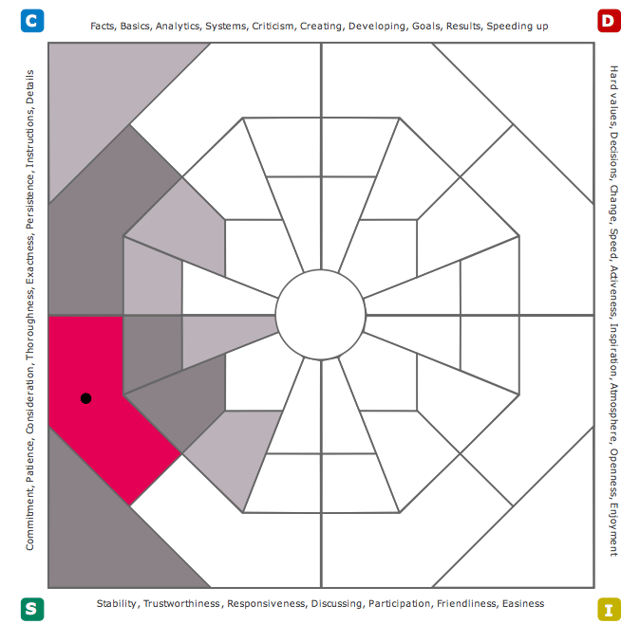According to the DISC theory you are classified as one of 4 DISC profiles. You may be the driven D-Style, the social I-Style, the steady S-Style, or the analytical C-Style. However, we are more complex and multi-dimensional than what a single DISC style can describe us as.
 DISC provides supporting information about a person for self-development and to help others interact more effectively with him/her. When we identify a person's DISC profile, we can map it on the DISC Model. The dot, representing a person's DISC profile, will be placed in one of the four DISC quadrants. The sample above shows a person who is a dominant S-profile. DISC recognizes we are complex human beings and beyond just a dot on the DISC graph. We all have additional DISC indicators that make it easier for us to adjust to various situations throughout the day without any additional energy.
DISC provides supporting information about a person for self-development and to help others interact more effectively with him/her. When we identify a person's DISC profile, we can map it on the DISC Model. The dot, representing a person's DISC profile, will be placed in one of the four DISC quadrants. The sample above shows a person who is a dominant S-profile. DISC recognizes we are complex human beings and beyond just a dot on the DISC graph. We all have additional DISC indicators that make it easier for us to adjust to various situations throughout the day without any additional energy.
The shaded area represents the DISC styles that are within a person's comfort zone. The DISC profiles are familiar for the person and traditionally don’t require additional energy for temporary shifts. However, someone will not prefer to "rest” in these DISC styles. They will always prefer to go back to their natural style when an adjustment is not required.
The non-shaded or white areas of the DISC Diamond map show all the DISC profiles requiring energy and effort. When we describe a person’s behavior we cannot say he can do something and cannot do something. We all have the potential to do everything; some things are simply more natural and some less natural.

Envision the DISC Diamond map as the place where you live. Your natural style is your home, where you feel the most comfortable. The shaded area around you is like your neighborhood. You are still residing in your comfort zone within this space. These are the DISC styles that are easy to stretch to in specific situations without being consciously aware of it. The lighter shaded area is like your section of town. You're familiar with the area, but sometimes you need to make a simple adjustment. For example, a new donut shop opened, but you have to think about which street corner it’s on.
If you are in a situation that requires you to adjust your behavioral style within your comfort areas, you will do it. It normally doesn’t require additional thought or energy. You'll also find it easy to understand and interact with others, whose natural style is within your comfort area. However, when the situation no longer pressures you to adjust within your comfort zone, you will tend to revert back to your natural DISC style.
The DISC profiles outside of your comfort area represent you going to a Big City. You're meeting friends for dinner and enjoying a night out. While it's fun and exciting, you may feel apprehensive. You may feel yourself exerting more energy and effort because you don’t know your way around downtown streets. Upon returning home, have you ever let out a sigh of contentment, simply because you're home?
DISC styles outside of your flexibility zone simply take more concentration and energy. It doesn’t feel as natural and you're more likely to get tired and feel drained. Additional energy may also be required when communicating with people outside of your comfort area. For example, you may need to learn how they communicate and express thoughts and feelings. How they show appreciation and handle criticism.
Now that you better understand the natural DISC style and the surrounding comfort area, you may want to reflect on how this may impact your job roles. Which part of your job fits within your comfort area? Try analyzing your job roles into specific behavioral responsibilities. For example, leading the weekly team meeting. If you identify the behavior of leading meetings as I-style or D-style, have you had to make adjustments or is it comfortable for you?
Are there specific parts of your job requiring you to move outside your comfort area? If so, do you need any type of support to effectively perform those duties? Think of the people in your work setting. How should you adjust your communication with people outside your comfort area?

Your comfort area helps identify your feelings when completing various tasks or when communicating with different types of people. It can provide supporting information for career development, teamwork, communication training, and even possibly, help with redefining your work style. Often, our jobs are hard enough with deadlines, daily interactions, and responsibilities. If you have more self-awareness of how you prefer to do things, make decisions, communicate, and show up under pressure, then you have a useful tool towards effective self-development. You can find your own DISC profile by taking the DISC Assessment.
